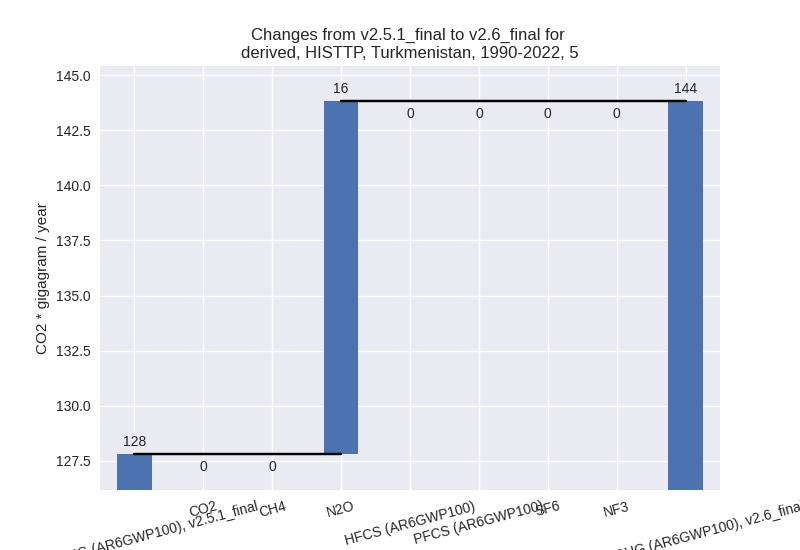Changes in PRIMAP-hist v2.6_final compared to v2.5.1_final for Turkmenistan
2024-09-24
Johannes Gütschow
Change analysis for Turkmenistan for PRIMAP-hist v2.6_final compared to v2.5.1_final
Overview over emissions by sector and gas
The following figures show the aggregate national total emissions excluding LULUCF AR6GWP100 for the country reported priority scenario. The dotted linesshow the v2.5.1_final data.
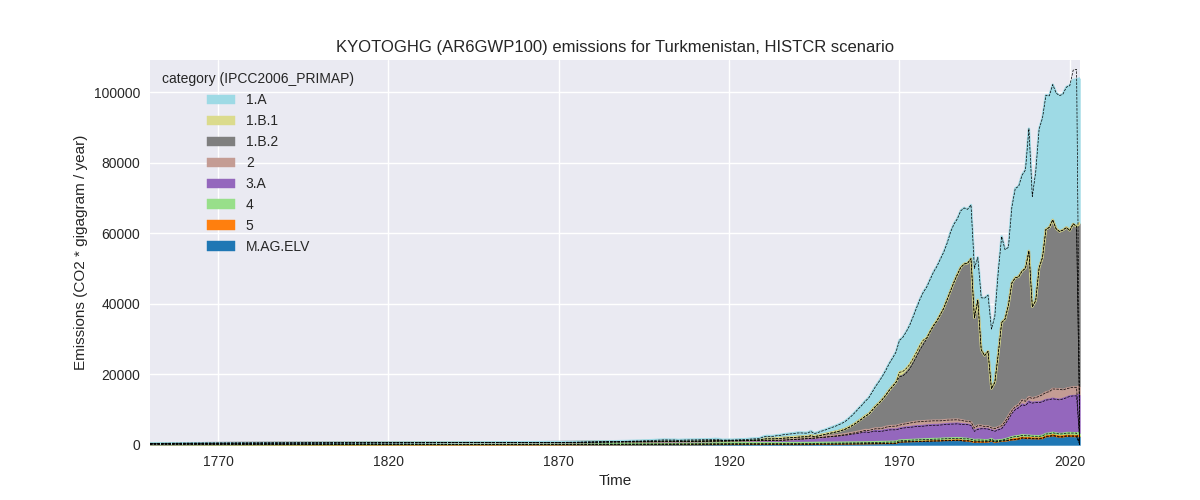
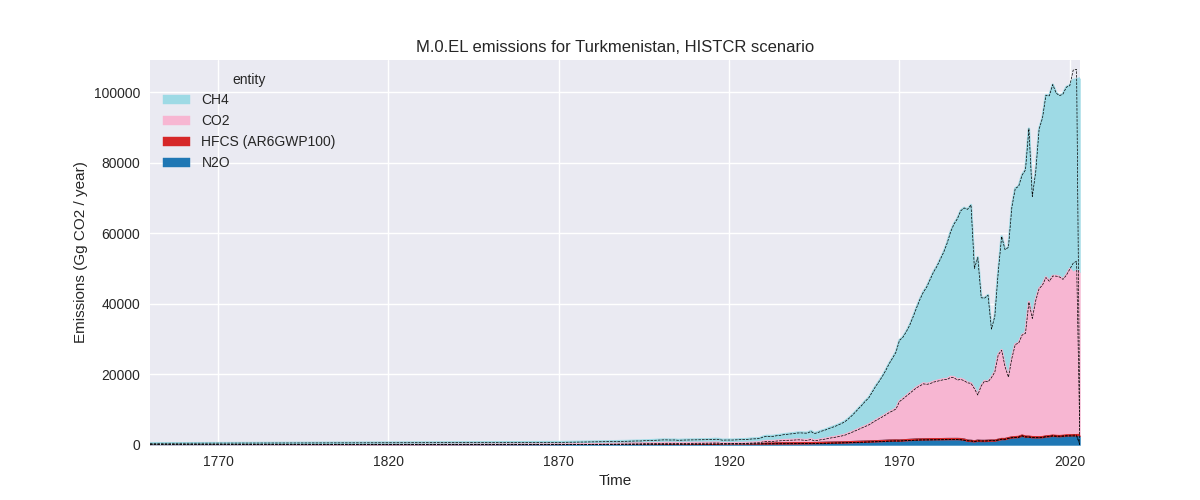
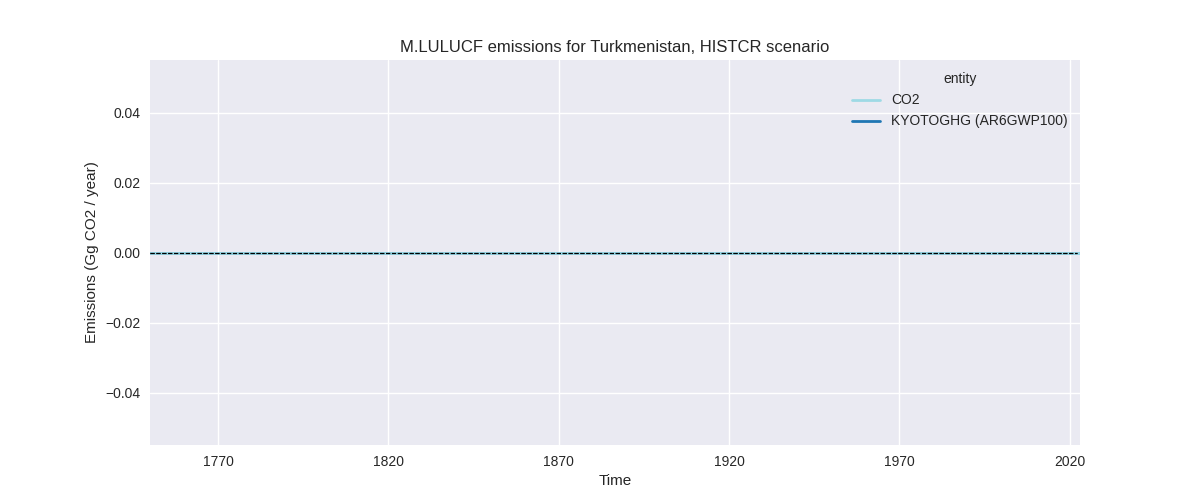
The following figures show the aggregate national total emissions excluding LULUCF AR6GWP100 for the third party priority scenario. The dotted linesshow the v2.5.1_final data.
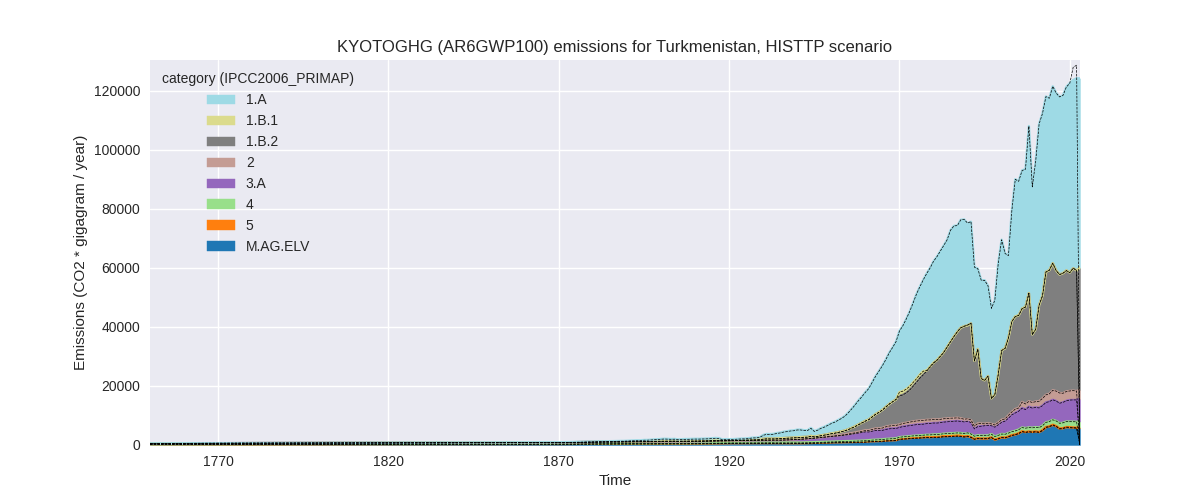
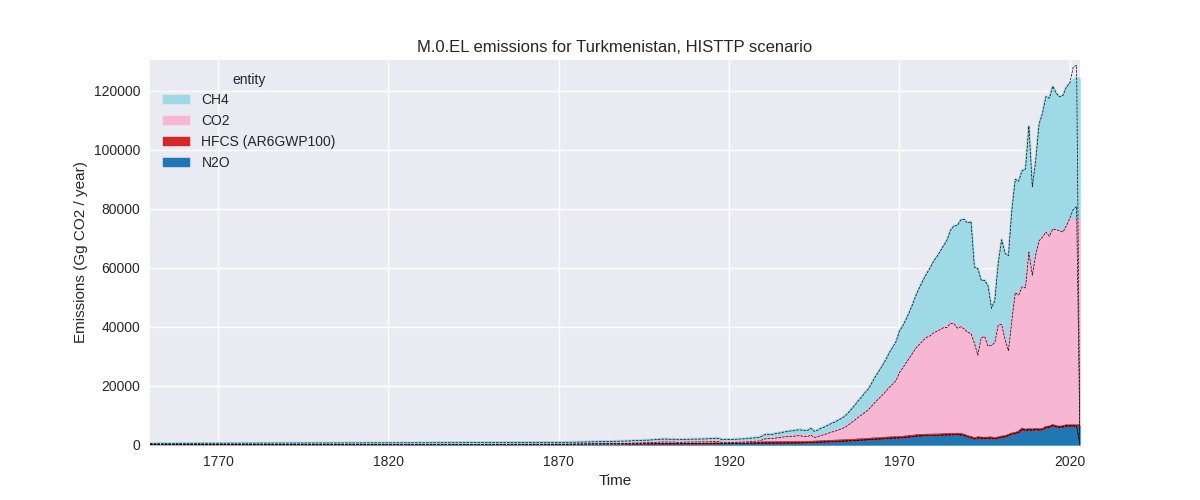
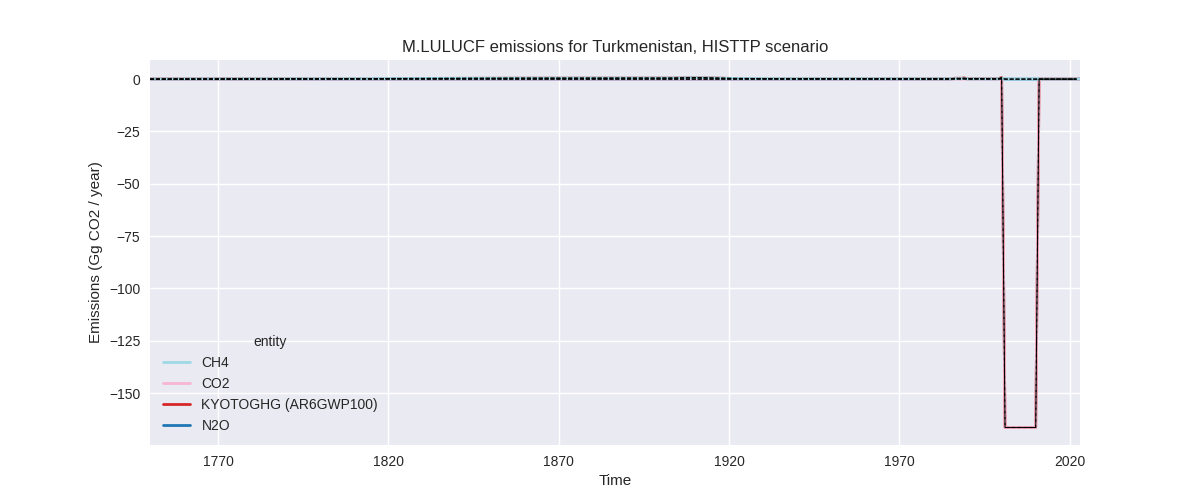
Overview over changes
In the country reported priority scenario we have the following changes for aggregate Kyoto GHG and national total emissions excluding LULUCF (M.0.EL):
- Emissions in 2022 have changed by -2.7%% (-2873.22 Gg CO2 / year)
- Emissions in 1990-2022 have changed by -0.2%% (-146.83 Gg CO2 / year)
In the third party priority scenario we have the following changes for aggregate Kyoto GHG and national total emissions excluding LULUCF (M.0.EL):
- Emissions in 2022 have changed by -3.5%% (-4445.02 Gg CO2 / year)
- Emissions in 1990-2022 have changed by -0.3%% (-250.80 Gg CO2 / year)
Most important changes per scenario and time frame
In the country reported priority scenario the following sector-gas combinations have the highest absolute impact on national total KyotoGHG (AR6GWP100) emissions in 2022 (top 5):
- 1: 1.A, CO2 with -2813.51 Gg CO2 / year (-6.3%)
- 2: 5, N2O with -37.24 Gg CO2 / year (-17.0%)
- 3: 1.B.2, CO2 with -29.59 Gg CO2 / year (-1.3%)
- 4: 1.B.1, CH4 with -27.54 Gg CO2 / year (-70.3%)
- 5: 1.B.1, CO2 with 25.20 Gg CO2 / year (inf%)
In the country reported priority scenario the following sector-gas combinations have the highest absolute impact on national total KyotoGHG (AR6GWP100) emissions in 1990-2022 (top 5):
- 1: 1.A, CO2 with -168.88 Gg CO2 / year (-0.6%)
- 2: 1.B.1, CO2 with 27.45 Gg CO2 / year (inf%)
- 3: 5, N2O with 16.00 Gg CO2 / year (12.5%)
- 4: 1.B.1, CH4 with -15.65 Gg CO2 / year (-57.2%)
- 5: 1.B.2, CO2 with -2.92 Gg CO2 / year (-0.2%)
In the third party priority scenario the following sector-gas combinations have the highest absolute impact on national total KyotoGHG (AR6GWP100) emissions in 2022 (top 5):
- 1: 1.A, CO2 with -4390.31 Gg CO2 / year (-6.3%)
- 2: 5, N2O with -37.24 Gg CO2 / year (-17.0%)
- 3: 1.B.2, CO2 with -29.59 Gg CO2 / year (-1.3%)
- 4: 1.B.1, CH4 with -27.54 Gg CO2 / year (-70.3%)
- 5: 1.B.1, CO2 with 25.20 Gg CO2 / year (inf%)
In the third party priority scenario the following sector-gas combinations have the highest absolute impact on national total KyotoGHG (AR6GWP100) emissions in 1990-2022 (top 5):
- 1: 1.A, CO2 with -263.52 Gg CO2 / year (-0.6%)
- 2: 1.B.1, CO2 with 27.45 Gg CO2 / year (inf%)
- 3: 5, N2O with 16.00 Gg CO2 / year (12.5%)
- 4: 1.B.1, CH4 with -15.65 Gg CO2 / year (-57.2%)
- 5: 4, CH4 with -11.16 Gg CO2 / year (-0.9%)
Notes on data changes
Here we list notes explaining important emissions changes for the country. ’' means that the following text only applies to the TP time series, while means that it only applies to the CR scenario. Otherwise the note applies to both scenarios.
- Changes in 1.A and 1.B.2 for 2021 and 2022 from updated EI data.
- Changes in sectors 4 and 5 are due to the removal of FAOSTAT data (CR, TP).
- CO2 from 1.B.1 is now small instead of 0 post 1990 due to the shorter extrapolation trend period (CR, TP).
Changes by sector and gas
For each scenario and time frame the changes are displayed for all individual sectors and all individual gases. In the sector plot we use aggregate Kyoto GHGs in AR6GWP100. In the gas plot we usenational total emissions without LULUCF. ## country reported scenario
2022
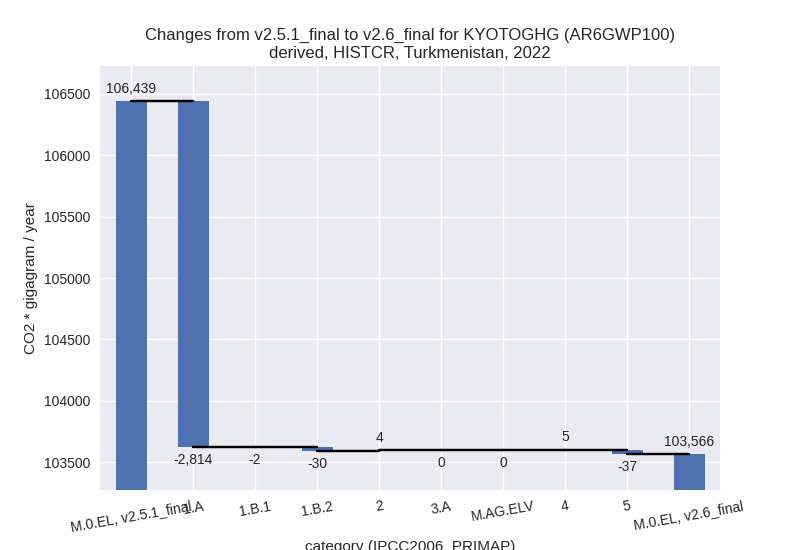
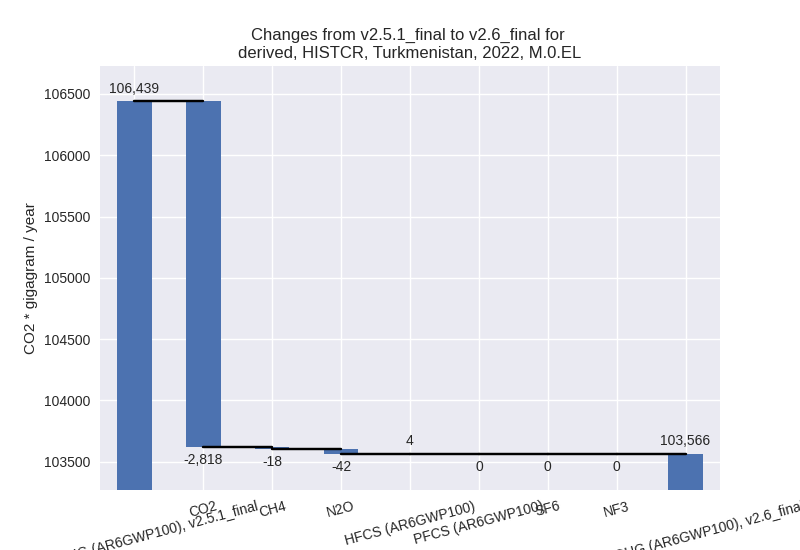
1990-2022
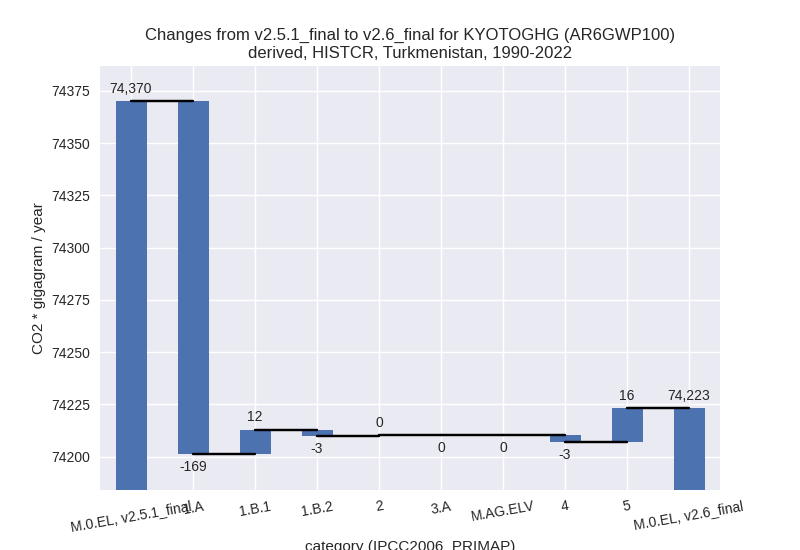
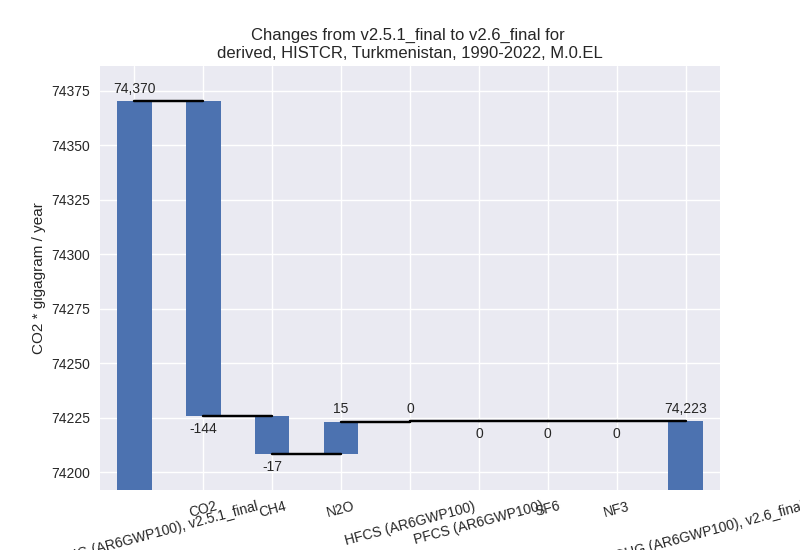
third party scenario
2022
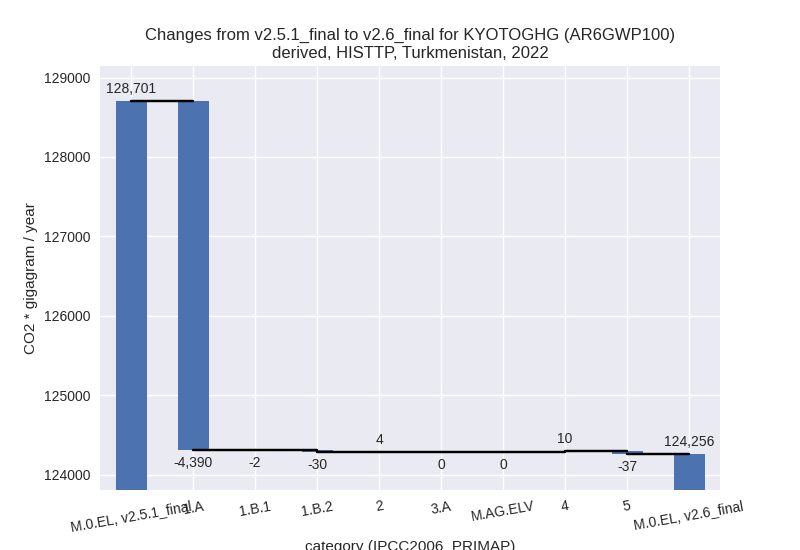
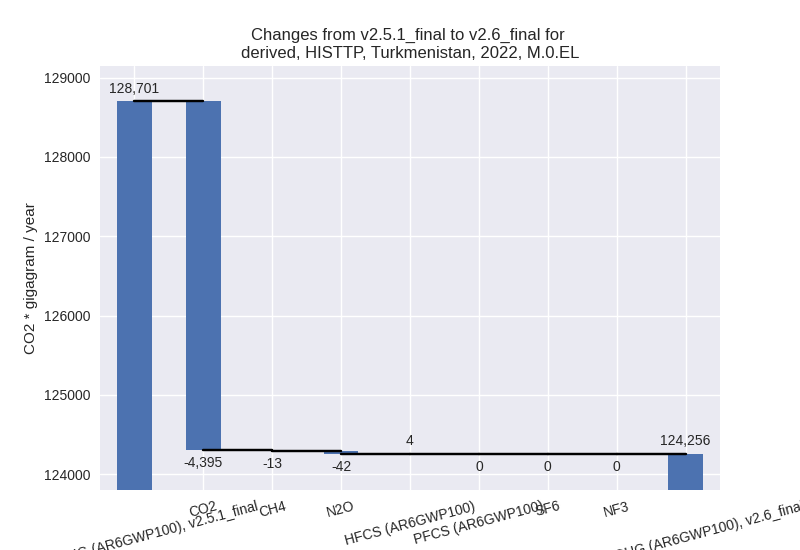
1990-2022
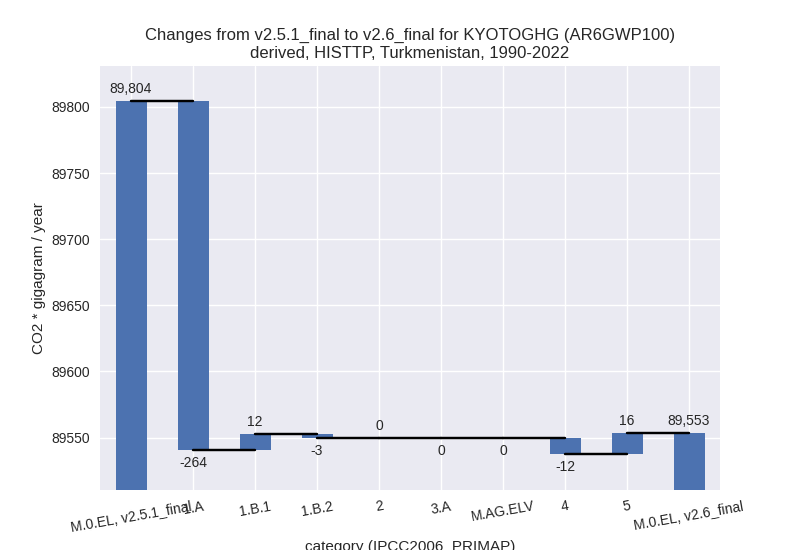
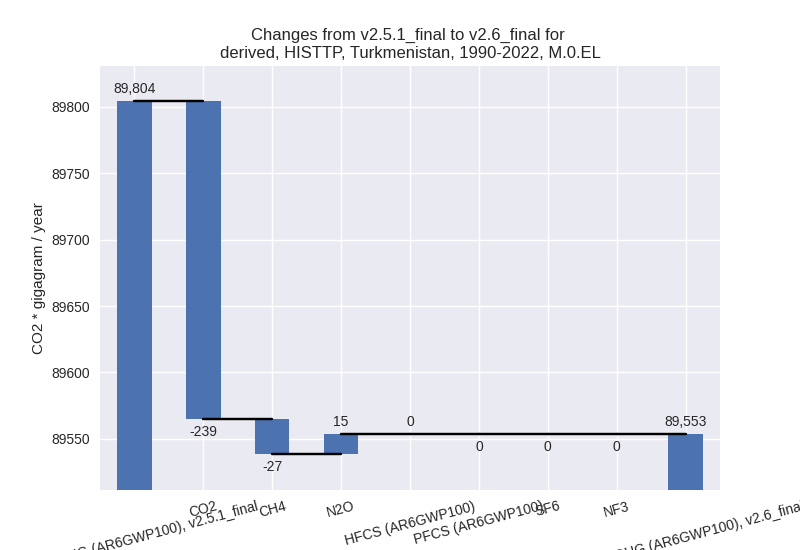
Detailed changes for the scenarios:
country reported scenario (HISTCR):
Most important changes per time frame
For 2022 the following sector-gas combinations have the highest absolute impact on national total KyotoGHG (AR6GWP100) emissions in 2022 (top 5):
- 1: 1.A, CO2 with -2813.51 Gg CO2 / year (-6.3%)
- 2: 5, N2O with -37.24 Gg CO2 / year (-17.0%)
- 3: 1.B.2, CO2 with -29.59 Gg CO2 / year (-1.3%)
- 4: 1.B.1, CH4 with -27.54 Gg CO2 / year (-70.3%)
- 5: 1.B.1, CO2 with 25.20 Gg CO2 / year (inf%)
For 1990-2022 the following sector-gas combinations have the highest absolute impact on national total KyotoGHG (AR6GWP100) emissions in 1990-2022 (top 5):
- 1: 1.A, CO2 with -168.88 Gg CO2 / year (-0.6%)
- 2: 1.B.1, CO2 with 27.45 Gg CO2 / year (inf%)
- 3: 5, N2O with 16.00 Gg CO2 / year (12.5%)
- 4: 1.B.1, CH4 with -15.65 Gg CO2 / year (-57.2%)
- 5: 1.B.2, CO2 with -2.92 Gg CO2 / year (-0.2%)
Changes in the main sectors for aggregate KyotoGHG (AR6GWP100) are
- 1: Total sectoral emissions in 2022 are 87296.94 Gg
CO2 / year which is 84.3% of M.0.EL emissions. 2022 Emissions have
changed by -3.2% (-2845.44 Gg CO2 /
year). 1990-2022 Emissions have changed by -0.3% (-160.00 Gg CO2 / year). For 2022
the changes per gas
are:
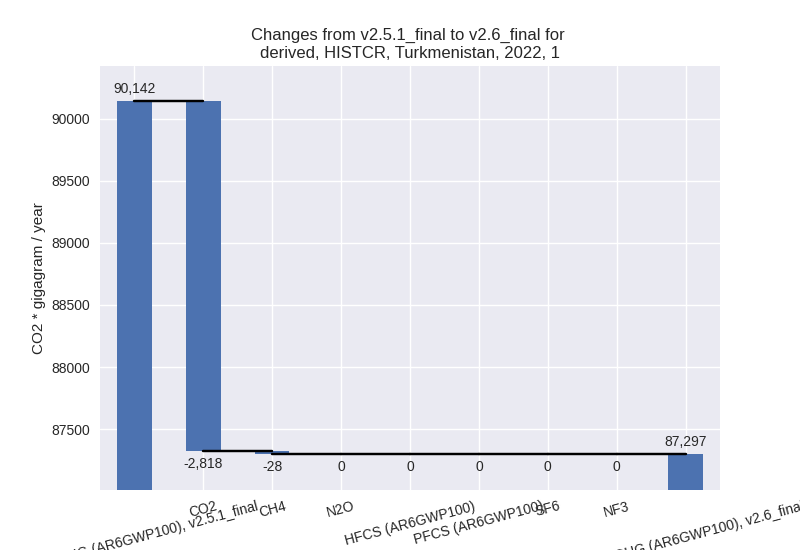
The changes come from the following subsectors:- 1.A: Total sectoral emissions in 2022 are 41651.97
Gg CO2 / year which is 47.7% of category 1 emissions. 2022 Emissions
have changed by -6.3% (-2813.51 Gg
CO2 / year). 1990-2022 Emissions have changed by -0.6% (-168.88 Gg CO2 / year). For 2022
the changes per gas
are:
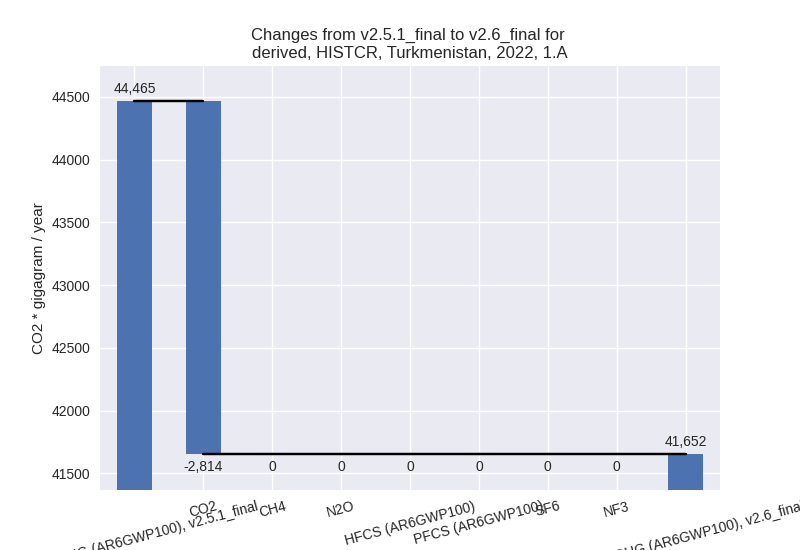
There is no subsector information available in PRIMAP-hist. - 1.B.1: Total sectoral emissions in 2022 are 36.82
Gg CO2 / year which is 0.0% of category 1 emissions. 2022 Emissions have
changed by -6.0% (-2.34 Gg CO2 /
year). 1990-2022 Emissions have changed by 43.1% (11.80 Gg CO2 / year). For 2022 the
changes per gas
are:
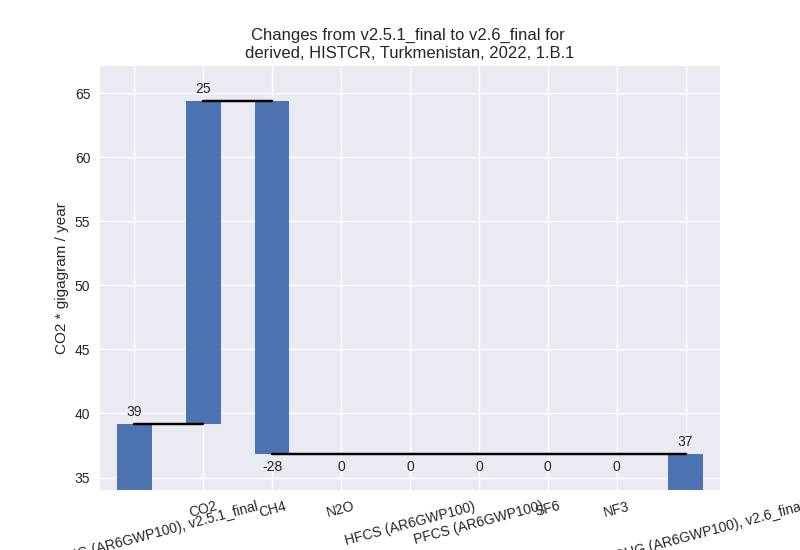
For 1990-2022 the changes per gas are: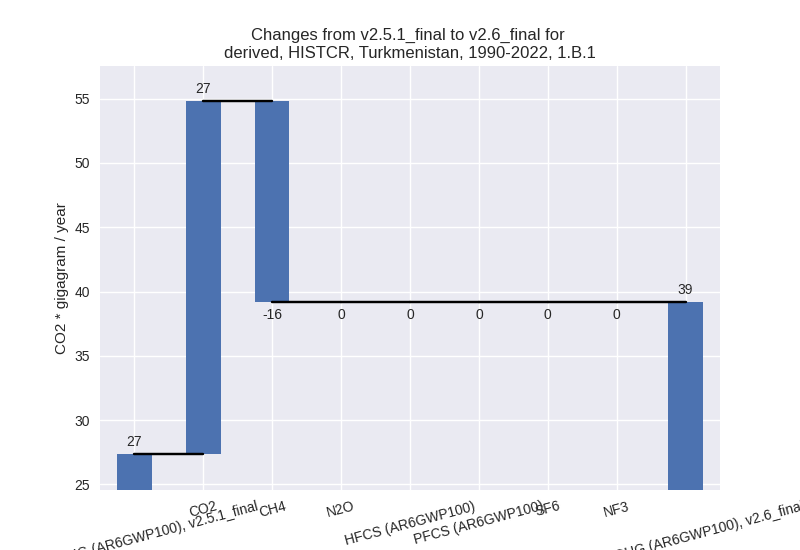
There is no subsector information available in PRIMAP-hist. - 1.B.2: Total sectoral emissions in 2022 are 45608.15 Gg CO2 / year which is 52.2% of category 1 emissions. 2022 Emissions have changed by -0.1% (-29.59 Gg CO2 / year). 1990-2022 Emissions have changed by -0.0% (-2.92 Gg CO2 / year).
- 1.A: Total sectoral emissions in 2022 are 41651.97
Gg CO2 / year which is 47.7% of category 1 emissions. 2022 Emissions
have changed by -6.3% (-2813.51 Gg
CO2 / year). 1990-2022 Emissions have changed by -0.6% (-168.88 Gg CO2 / year). For 2022
the changes per gas
are:
- 2: Total sectoral emissions in 2022 are 2381.78 Gg CO2 / year which is 2.3% of M.0.EL emissions. 2022 Emissions have changed by 0.2% (4.06 Gg CO2 / year). 1990-2022 Emissions have changed by 0.0% (0.12 Gg CO2 / year).
- M.AG: Total sectoral emissions in 2022 are 12902.06 Gg CO2 / year which is 12.5% of M.0.EL emissions. 2022 Emissions have changed by 0.0% (0.00 Gg CO2 / year). 1990-2022 Emissions have changed by 0.0% (0.00 Gg CO2 / year).
- 4: Total sectoral emissions in 2022 are 803.65 Gg CO2 / year which is 0.8% of M.0.EL emissions. 2022 Emissions have changed by 0.7% (5.40 Gg CO2 / year). 1990-2022 Emissions have changed by -0.5% (-2.95 Gg CO2 / year).
- 5: Total sectoral emissions in 2022 are 181.64 Gg
CO2 / year which is 0.2% of M.0.EL emissions. 2022 Emissions have
changed by -17.0% (-37.24 Gg CO2 /
year). 1990-2022 Emissions have changed by 12.5% (16.00 Gg CO2 / year). For 2022 the
changes per gas
are:
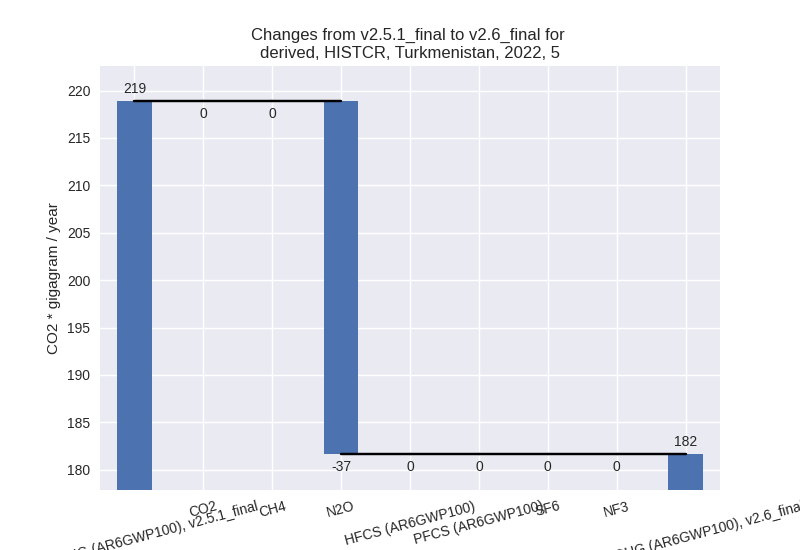
For 1990-2022 the changes per gas are: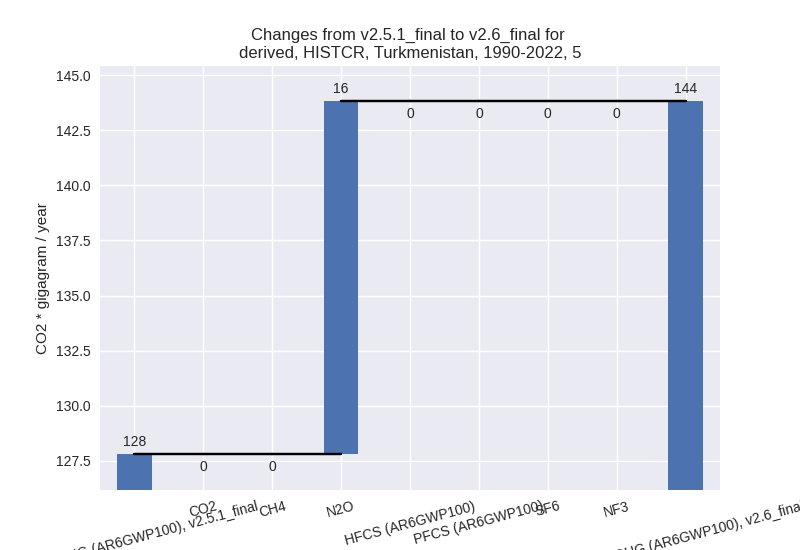
third party scenario (HISTTP):
Most important changes per time frame
For 2022 the following sector-gas combinations have the highest absolute impact on national total KyotoGHG (AR6GWP100) emissions in 2022 (top 5):
- 1: 1.A, CO2 with -4390.31 Gg CO2 / year (-6.3%)
- 2: 5, N2O with -37.24 Gg CO2 / year (-17.0%)
- 3: 1.B.2, CO2 with -29.59 Gg CO2 / year (-1.3%)
- 4: 1.B.1, CH4 with -27.54 Gg CO2 / year (-70.3%)
- 5: 1.B.1, CO2 with 25.20 Gg CO2 / year (inf%)
For 1990-2022 the following sector-gas combinations have the highest absolute impact on national total KyotoGHG (AR6GWP100) emissions in 1990-2022 (top 5):
- 1: 1.A, CO2 with -263.52 Gg CO2 / year (-0.6%)
- 2: 1.B.1, CO2 with 27.45 Gg CO2 / year (inf%)
- 3: 5, N2O with 16.00 Gg CO2 / year (12.5%)
- 4: 1.B.1, CH4 with -15.65 Gg CO2 / year (-57.2%)
- 5: 4, CH4 with -11.16 Gg CO2 / year (-0.9%)
Changes in the main sectors for aggregate KyotoGHG (AR6GWP100) are
- 1: Total sectoral emissions in 2022 are 106003.89
Gg CO2 / year which is 85.3% of M.0.EL emissions. 2022 Emissions have
changed by -4.0% (-4422.23 Gg CO2 /
year). 1990-2022 Emissions have changed by -0.3% (-254.65 Gg CO2 / year). For 2022
the changes per gas
are:
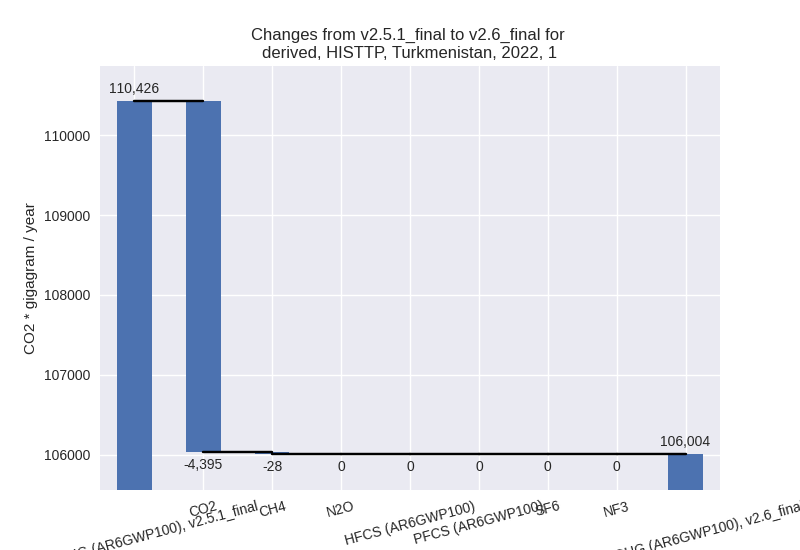
The changes come from the following subsectors:- 1.A: Total sectoral emissions in 2022 are 65123.84
Gg CO2 / year which is 61.4% of category 1 emissions. 2022 Emissions
have changed by -6.3% (-4390.31 Gg
CO2 / year). 1990-2022 Emissions have changed by -0.6% (-263.52 Gg CO2 / year). For 2022
the changes per gas
are:
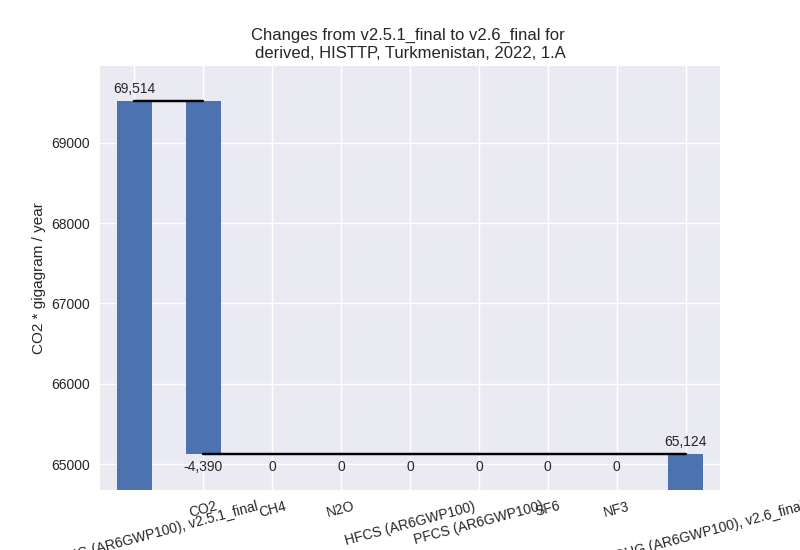
There is no subsector information available in PRIMAP-hist. - 1.B.1: Total sectoral emissions in 2022 are 36.82
Gg CO2 / year which is 0.0% of category 1 emissions. 2022 Emissions have
changed by -6.0% (-2.34 Gg CO2 /
year). 1990-2022 Emissions have changed by 43.1% (11.80 Gg CO2 / year). For 2022 the
changes per gas
are:
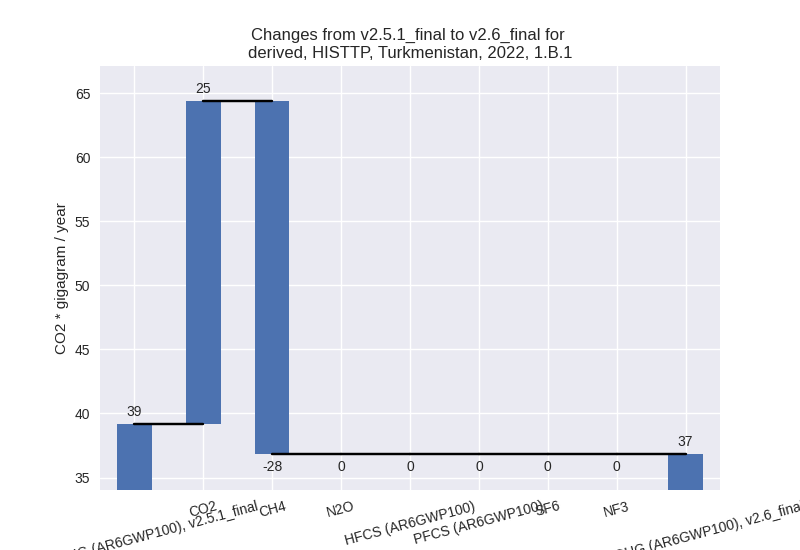
For 1990-2022 the changes per gas are: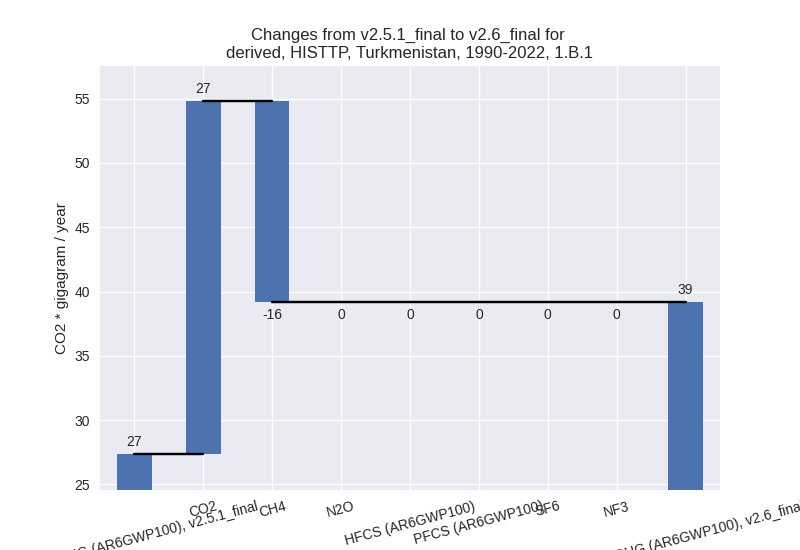
There is no subsector information available in PRIMAP-hist. - 1.B.2: Total sectoral emissions in 2022 are 40843.23 Gg CO2 / year which is 38.5% of category 1 emissions. 2022 Emissions have changed by -0.1% (-29.59 Gg CO2 / year). 1990-2022 Emissions have changed by -0.0% (-2.92 Gg CO2 / year).
- 1.A: Total sectoral emissions in 2022 are 65123.84
Gg CO2 / year which is 61.4% of category 1 emissions. 2022 Emissions
have changed by -6.3% (-4390.31 Gg
CO2 / year). 1990-2022 Emissions have changed by -0.6% (-263.52 Gg CO2 / year). For 2022
the changes per gas
are:
- 2: Total sectoral emissions in 2022 are 3002.37 Gg CO2 / year which is 2.4% of M.0.EL emissions. 2022 Emissions have changed by 0.1% (4.06 Gg CO2 / year). 1990-2022 Emissions have changed by 0.0% (0.12 Gg CO2 / year).
- M.AG: Total sectoral emissions in 2022 are 13069.93 Gg CO2 / year which is 10.5% of M.0.EL emissions. 2022 Emissions have changed by 0.0% (0.00 Gg CO2 / year). 1990-2022 Emissions have changed by 0.0% (0.00 Gg CO2 / year).
- 4: Total sectoral emissions in 2022 are 1998.59 Gg CO2 / year which is 1.6% of M.0.EL emissions. 2022 Emissions have changed by 0.5% (10.38 Gg CO2 / year). 1990-2022 Emissions have changed by -0.9% (-12.27 Gg CO2 / year).
- 5: Total sectoral emissions in 2022 are 181.64 Gg
CO2 / year which is 0.1% of M.0.EL emissions. 2022 Emissions have
changed by -17.0% (-37.24 Gg CO2 /
year). 1990-2022 Emissions have changed by 12.5% (16.00 Gg CO2 / year). For 2022 the
changes per gas
are:
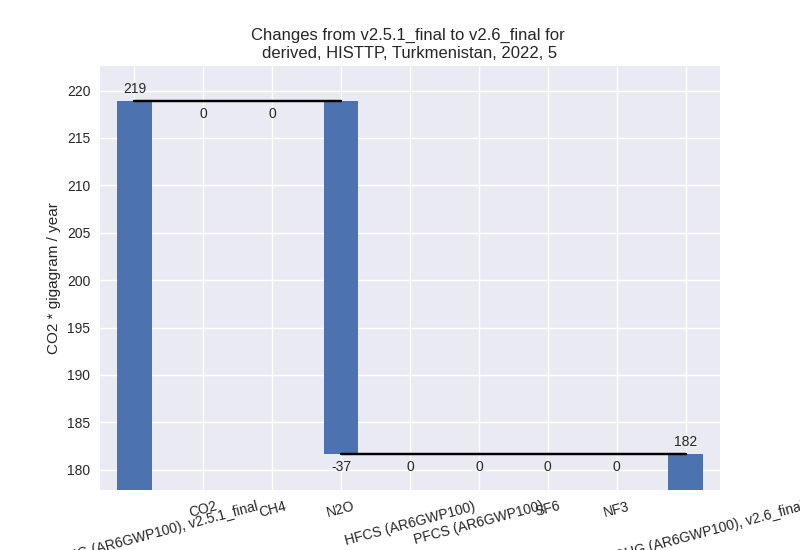
For 1990-2022 the changes per gas are: